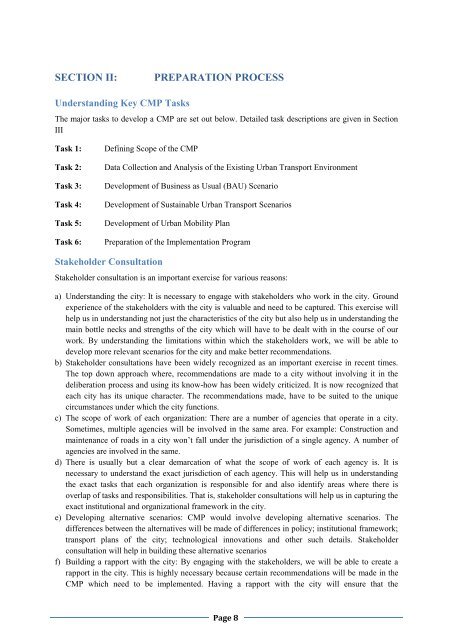Toolkits for Urban Transport Development - UNEP
Toolkits for Urban Transport Development - UNEP
Toolkits for Urban Transport Development - UNEP
Create successful ePaper yourself
Turn your PDF publications into a flip-book with our unique Google optimized e-Paper software.
SECTION II:<br />
PREPARATION PROCESS<br />
Understanding Key CMP Tasks<br />
The major tasks to develop a CMP are set out below. Detailed task descriptions are given in Section<br />
III<br />
Task 1:<br />
Task 2:<br />
Task 3:<br />
Task 4:<br />
Task 5:<br />
Task 6:<br />
Defining Scope of the CMP<br />
Data Collection and Analysis of the Existing <strong>Urban</strong> <strong>Transport</strong> Environment<br />
<strong>Development</strong> of Business as Usual (BAU) Scenario<br />
<strong>Development</strong> of Sustainable <strong>Urban</strong> <strong>Transport</strong> Scenarios<br />
<strong>Development</strong> of <strong>Urban</strong> Mobility Plan<br />
Preparation of the Implementation Program<br />
Stakeholder Consultation<br />
Stakeholder consultation is an important exercise <strong>for</strong> various reasons:<br />
a) Understanding the city: It is necessary to engage with stakeholders who work in the city. Ground<br />
experience of the stakeholders with the city is valuable and need to be captured. This exercise will<br />
help us in understanding not just the characteristics of the city but also help us in understanding the<br />
main bottle necks and strengths of the city which will have to be dealt with in the course of our<br />
work. By understanding the limitations within which the stakeholders work, we will be able to<br />
develop more relevant scenarios <strong>for</strong> the city and make better recommendations.<br />
b) Stakeholder consultations have been widely recognized as an important exercise in recent times.<br />
The top down approach where, recommendations are made to a city without involving it in the<br />
deliberation process and using its know-how has been widely criticized. It is now recognized that<br />
each city has its unique character. The recommendations made, have to be suited to the unique<br />
circumstances under which the city functions.<br />
c) The scope of work of each organization: There are a number of agencies that operate in a city.<br />
Sometimes, multiple agencies will be involved in the same area. For example: Construction and<br />
maintenance of roads in a city won’t fall under the jurisdiction of a single agency. A number of<br />
agencies are involved in the same.<br />
d) There is usually but a clear demarcation of what the scope of work of each agency is. It is<br />
necessary to understand the exact jurisdiction of each agency. This will help us in understanding<br />
the exact tasks that each organization is responsible <strong>for</strong> and also identify areas where there is<br />
overlap of tasks and responsibilities. That is, stakeholder consultations will help us in capturing the<br />
exact institutional and organizational framework in the city.<br />
e) Developing alternative scenarios: CMP would involve developing alternative scenarios. The<br />
differences between the alternatives will be made of differences in policy; institutional framework;<br />
transport plans of the city; technological innovations and other such details. Stakeholder<br />
consultation will help in building these alternative scenarios<br />
f) Building a rapport with the city: By engaging with the stakeholders, we will be able to create a<br />
rapport in the city. This is highly necessary because certain recommendations will be made in the<br />
CMP which need to be implemented. Having a rapport with the city will ensure that the<br />
Page 8
















